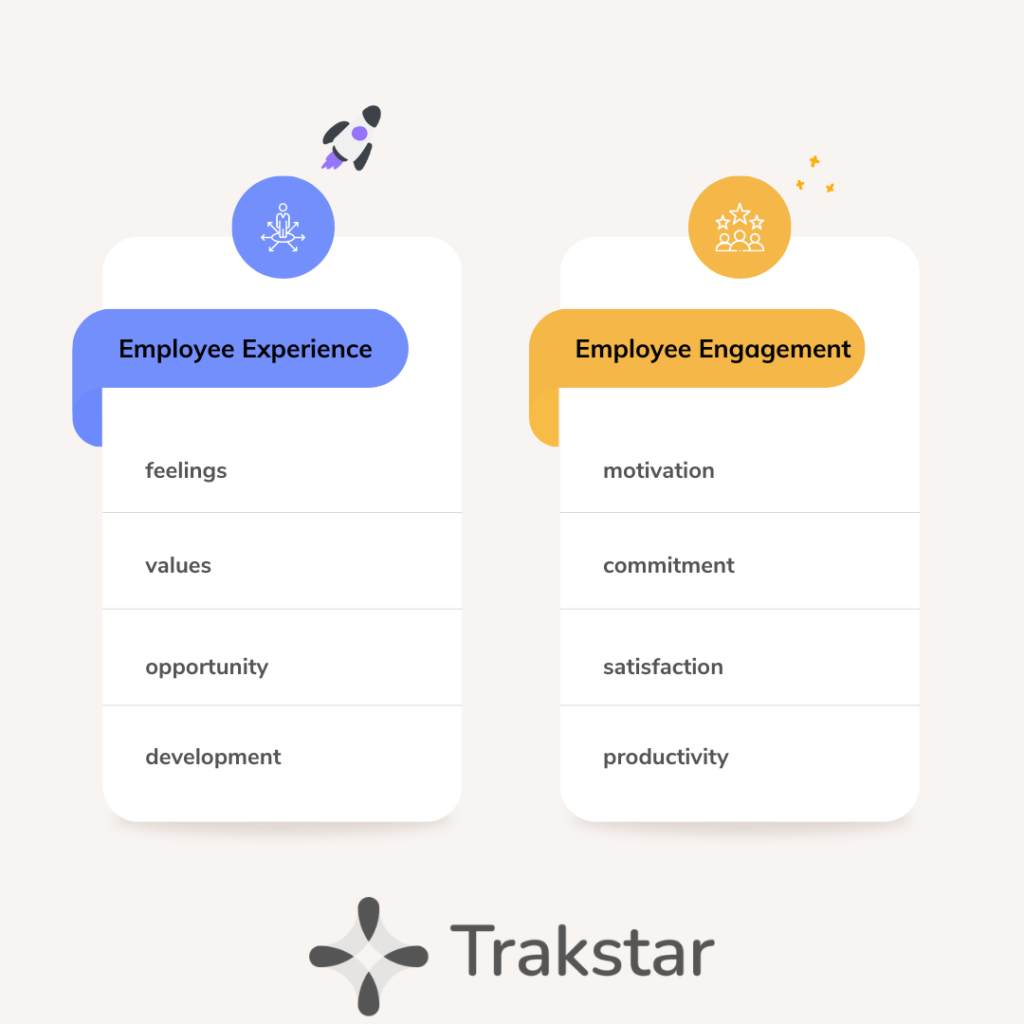Employee Experience vs. Engagement
Posted by Trakstar • May 5, 2023 • 7 min read
Are your employees merely engaged, or are they genuinely experiencing their work and enjoying it? When comparing employee engagement vs. experience, you might think that taking care of one thing is enough, but you must consider both.
It’s very easy to confuse the two, but understanding the difference between employee experience and engagement can create a positive workplace culture and increase satisfaction.
If you’re new to these terms, keep reading! We’ll delve into what these terms mean, why employee experience is crucial for any business looking to succeed with a modern workforce, how to get employee feedback, and provide tips on improving your organization’s employee experience and company culture.
If you’re ready to transform your employee journey and want to start by providing Human Resources with the software they need to be successful and promote employee wellbeing, schedule a demo of Trakstar today.
What is Employee Experience?
Employee experience is a relatively new term in the business world, but it has quickly become a buzzword among HR professionals and executives interested in what the engaged employee wants.
So what exactly does it really mean?
At its core, employee experience refers to how employees feel about their work environment, from their physical space to their interactions with colleagues and managers. A positive employee experience encourages your employee to come to work, do their best, and even work to improve internal communication about any problems. A great employee experience will encourage an employee to grow within your company and complete the employee lifecycle with you. This is hard to do with the modern workforce as more and more people leave organizations after a set amount of years.
The employee experience encompasses everything from company culture to compensation packages, benefits programs, training opportunities, employee retention, and beyond. Essentially, it represents every touchpoint an employee has within your organization and within the employee life cycle. HR professionals bear most of the weight when it comes to creating happy employees, high employee engagement rates, and a positive experience for those employees.
It’s a lot! But it is very important.
Ultimately, ensuring that your team members have a positive culture, whether the workplace is digital or in person, can lead to greater job satisfaction and productivity within the company and less employee turnover. In today’s tech-driven world, where remote work is becoming more prevalent than ever before, companies need to focus on creating an engaging virtual environment that allows people to connect seamlessly, regardless of location.
Still, a good employee experience starts with the workplace and, often, good employee relationships.

What is Employee Engagement?
Employee engagement is a term used to describe employee commitment and enthusiasm toward their job. It refers to how invested employees are in their work, motivation, and willingness to go above and beyond to reach personal and departmental goals and align with organizational strategies.
Engaged employees are passionate about their work and take pride in it. Often, they do so beyond career development opportunities and beyond receiving a paycheck. This leads to increased productivity, higher quality of work, improved customer satisfaction, and reduced turnover. This doesn’t mean that engaged employees can’t leave their jobs, so holding an exit interview may be an excellent strategy for employees with high engagement scores.
Many factors contribute to employee engagement, such as good management practices, clear communication channels, discretionary effort, recognition for achievements, and company growth opportunities. If your company felt the pull of the Great Resignation, you likely focused on engaging disengaged employees using some of those efforts.
Employee engagement can be measured through various methods, including surveys or feedback sessions with managers or HR personnel. Employee performance can be tied to employee engagement, which is why Trakstar Perform contains a module that helps leaders run engagement surveys, conduct employee check-ins, and just get the general pulse of workplace culture.
By understanding your workforce’s level of engagement, you can identify areas where improvements are necessary, ultimately leading to more satisfied employees who contribute positively towards your business goals.
The Differences Between Employee Experience and Engagement
Employee experience and employee engagement are often used interchangeably, but they have different meanings, particularly when looking at data and metrics surrounding Human Resources efforts. Employee engagement refers to an employee’s emotional attachment to their workplace, job, colleagues, and culture. It is measured by motivation, commitment, satisfaction, and productivity. It’s easier to spot disengaged employees than find the ones with high engagement rates.
On the other hand, employee experience is a broader term encompassing all aspects of an employee’s interactions with their employer from recruitment to exit. It includes everything from work environment to company culture and values, training opportunities, and development programs. It is harder to find employees who are not having a good experience. Often, they fall behind and simply get by. Sometimes, they’re subject to Zoom fatigue, burnout, and quiet quitting.
Employee engagement focuses on how employees feel about their work, while experience examines every aspect of the workplace environment that shapes those feelings. While both concepts aim at improving employees’ performance and satisfaction levels in the workplace, focusing only on one may not necessarily lead to better results.
Employee Engagement Solutions
An employer can improve its digital employee experience by utilizing talent management software built around organizational alignment, creating a good experience strategy, workplace culture, employee retention, and overall feelings. Trakstar’s suite of best-in-breed talent management software puts the worker and Human Resources at the organization’s center. By centralizing well-being, performance reviews, learning and development opportunities, applicant tracking, and engagement levels, Trakstar’s platform is a central part of any employee experience strategy.
Click here to schedule a demo today.
Understanding these two terms’ differences is key when developing strategies to improve overall workforce well-being within organizations. By attending to both areas simultaneously using a comprehensive approach where possible will help companies create workplaces where employees thrive holistically rather than just focusing solely on individual parts.

Why the Employee Experience is Important
The employee experience is crucial to the success of any organization. It refers to every employee’s interaction with their employer, including recruitment, onboarding, work environment, management style, and growth opportunities. It all comes back to talent management and creating happy employees who like what they do and see a future in what they’re doing.
Improving the employee experience can lead to several benefits, such as increased job satisfaction and happiness, which results in higher productivity levels. Employees who feel valued and supported are likelier to stay with their employer longer.
Improving how employees view the workplace can also enhance your brand reputation; satisfied employees will spread good word-of-mouth about their company which could attract top talent.
How to Improve Employee Experience
Improving employee experience is crucial for any organization that wants to attract and retain top talent. Here are some ways to do it:
- Clear communication: Ensure employees understand their roles, responsibilities, and goals by providing regular feedback and clear expectations. Use your performance management software to align your organization around specific goals.
- Invest in training and development: Offer opportunities for career growth through training programs, mentorship, or coaching. Consider a learning management system like Trakstar Learn!
- Foster a positive work environment: Create an inclusive workplace culture where all employees feel respected and valued.
- Recognize and reward employee achievements: Celebrate milestones and accomplishments with personalized recognition programs or incentives.
- Encourage work-life balance: Promote the importance of taking breaks during the day to recharge mentally; offer flexible schedules whenever possible; encourage vacation time usage; provide wellness initiatives such as gym memberships or mental health resources.
By prioritizing these strategies, organizations can create a more engaged workforce, leading to increased productivity, creativity, commitment – overall success!
Ready to Go Further with Employee Experience and Employee Engagement?
In today’s world, digital employee experience has become a critical aspect of a company’s success. It is no longer enough to focus solely on employee engagement. Companies must also prioritize creating and maintaining an exceptional employee experience.
By understanding the difference between employee experience and engagement, companies can craft comprehensive strategies considering both. Employee experience management software and platforms can help organizations gather feedback through surveys, identify areas for improvement, and track progress over time.
Ultimately, prioritizing your employees will lead to more engaged employees motivated to do their best every day. And when employees feel valued by their employers and have positive experiences at work, they are more likely to stay with the company long-term.
Click here to schedule a demo of Trakstar to start your employee experience strategy.
Don't Miss Out on More Great HR Articles!
Subscribe to get the latest, greatest HR and Talent Development content straight to your inbox.


